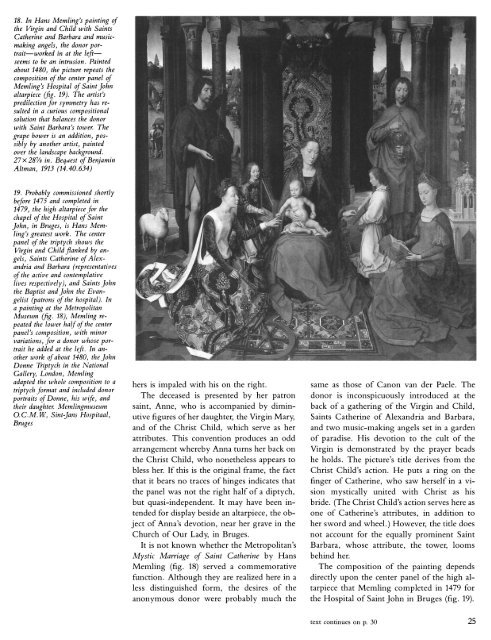Early Flemish Portraits 1425-1525: The Metropolitan Museum of Art ...
Early Flemish Portraits 1425-1525: The Metropolitan Museum of Art ...
Early Flemish Portraits 1425-1525: The Metropolitan Museum of Art ...
Create successful ePaper yourself
Turn your PDF publications into a flip-book with our unique Google optimized e-Paper software.
18. In Hans Memling's painting <strong>of</strong><br />
the Virgin and Child with Saints<br />
Catherine and Barbara and musicmaking<br />
angels, the donor portrait-worked<br />
in at the leftseems<br />
to be an intrusion. Painted<br />
about 1480, the picture repeats the<br />
composition <strong>of</strong> the center panel <strong>of</strong><br />
Memling's Hospital <strong>of</strong> Saint John<br />
altarpiece (fig. 19). <strong>The</strong> artist's<br />
predilection for symmetry has resulted<br />
in a curious compositional<br />
solution that balances the donor<br />
with Saint Barbara's tower. <strong>The</strong><br />
grape bower is an addition, possibly<br />
by another artist, painted<br />
over the landscape background.<br />
27 287/8 in. Bequest <strong>of</strong> Benjamin<br />
Altman, 1913 (14.40.634)<br />
19. Probably commissioned shortly<br />
before 1475 and completed in<br />
1479, the high altarpiece for the<br />
chapel <strong>of</strong> the Hospital <strong>of</strong> Saint<br />
John, in Bruges, is Hans Memling's<br />
greatest work. <strong>The</strong> center<br />
panel <strong>of</strong> the triptych shows the<br />
Virgin and Child flanked by angels,<br />
Saints Catherine <strong>of</strong> Alexandria<br />
and Barbara (representatives<br />
<strong>of</strong> the active and contemplative<br />
lives respectively), and SaintsJohn<br />
the Baptist andJohn the Evangelist<br />
(patrons <strong>of</strong> the hospital). In<br />
a painting at the <strong>Metropolitan</strong><br />
<strong>Museum</strong> (fig. 18), Memling repeated<br />
the lower half <strong>of</strong> the center<br />
panel's composition, with minor<br />
variations, for a donor whose portrait<br />
he added at the left. In another<br />
work <strong>of</strong> about 1480, the John<br />
Donne Triptych in the National<br />
Gallery, London, Memling<br />
adapted the whole composition to a<br />
triptych format and included donor<br />
portraits <strong>of</strong> Donne, his wife, and<br />
their daughter. Memlingmuseum<br />
O.C.M.W, Sint-Jans Hospitaal,<br />
Bruges<br />
hers is impaled with his on the right.<br />
<strong>The</strong> deceased is presented by her patron<br />
saint, Anne, who is accompanied by diminutive<br />
figures <strong>of</strong> her daughter, the Virgin Mary,<br />
and <strong>of</strong> the Christ Child, which serve as her<br />
attributes. This convention produces an odd<br />
arrangement whereby Anna turns her back on<br />
the Christ Child, who nonetheless appears to<br />
bless her. If this is the original frame, the fact<br />
that it bears no traces <strong>of</strong> hinges indicates that<br />
the panel was not the right half <strong>of</strong> a diptych,<br />
but quasi-independent. It may have been intended<br />
for display beside an altarpiece, the object<br />
<strong>of</strong> Anna's devotion, near her grave in the<br />
Church <strong>of</strong> Our Lady, in Bruges.<br />
It is not known whether the <strong>Metropolitan</strong>'s<br />
Mystic Marriage <strong>of</strong> Saint Catherine by Hans<br />
Memling (fig. 18) served a commemorative<br />
function. Although they are realized here in a<br />
less distinguished form, the desires <strong>of</strong> the<br />
anonymous donor were probably much the<br />
same as those <strong>of</strong> Canon van der Paele. <strong>The</strong><br />
donor is inconspicuously introduced at the<br />
back <strong>of</strong> a gathering <strong>of</strong> the Virgin and Child,<br />
Saints Catherine <strong>of</strong> Alexandria and Barbara,<br />
and two music-making angels set in a garden<br />
<strong>of</strong> paradise. His devotion to the cult <strong>of</strong> the<br />
Virgin is demonstrated by the prayer beads<br />
he holds. <strong>The</strong> picture's title derives from the<br />
Christ Child's action. He puts a ring on the<br />
finger <strong>of</strong> Catherine, who saw herself in a vision<br />
mystically united with Christ as his<br />
bride. (<strong>The</strong> Christ Child's action serves here as<br />
one <strong>of</strong> Catherine's attributes, in addition to<br />
her sword and wheel.) However, the title does<br />
not account for the equally prominent Saint<br />
Barbara, whose attribute, the tower, looms<br />
behind her.<br />
<strong>The</strong> composition <strong>of</strong> the painting depends<br />
directly upon the center panel <strong>of</strong> the high altarpiece<br />
that Memling completed in 1479 for<br />
the Hospital <strong>of</strong> Saint John in Bruges (fig. 19).<br />
text continues on p. 30 25

















